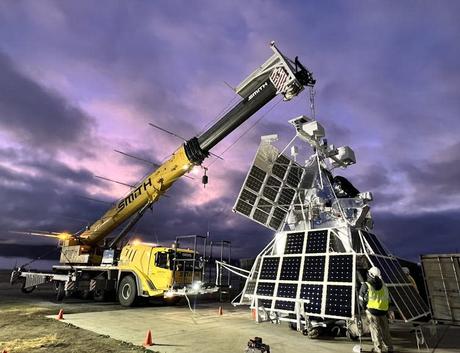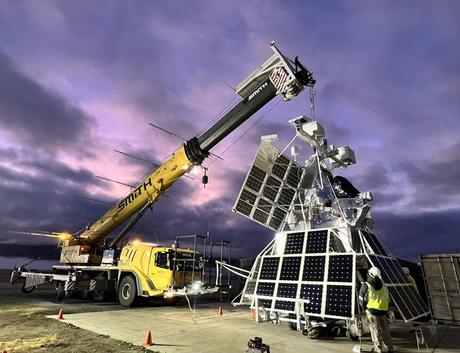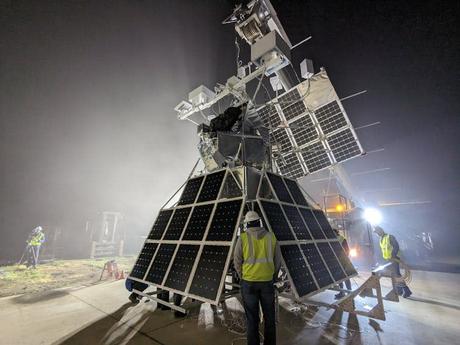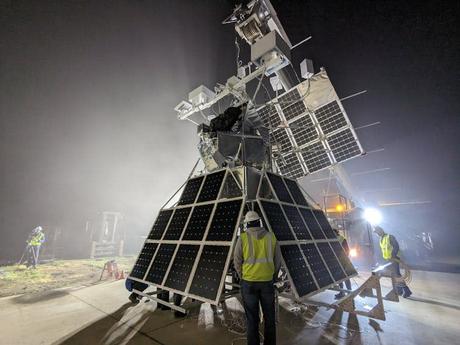SuperBIT awaits launch as its giant helium balloon inflates. Bill Rodman/NASA
An astronomical telescope designed to complement the aging Hubble Space Telescope was launched from New Zealand’s South Island on April 16, 2023. But as a sphere the size of a football stadium rose quietly and slowly over the Tauhinukorokio Mountains, calls from residents started coming in.
However, local police and radio stations had been informed by NASA that the giant helium balloon would lift the two-ton SuperBIT telescope to 40 km above sea level in the next three hours. The mission we were involved in was to test whether a telescope in a balloon could capture deep space images at a high enough resolution to study the unknown substance called dark matter, which is 85% of all the material in the universe.
The observations and subsequent data analysis have proven that balloon experiments can be just as useful as rocket-launched experiments, but are much cheaper. It is now up to scientists, government agencies and private companies to make the best of it.
The following month, polar stratospheric winds carried SuperBIT around the globe every eight days, mainly over the Antarctic ocean, but over the tip of South America. He went where the wind took him, but could look in all directions.

Flight path of SuperBIT, five and a half times around the Southern Ocean.
Solar panels charged the batteries every day. At night, it photographed the sky, including the Tarantula Nebula, a light source 160,000 light-years away, and clusters of galaxies 20,000 times further away.
Without a tripod, SuperBIT used gyroscopes to stabilize every move (we found that the stratosphere is remarkably calm… except in the turbulence over the Andes, where SuperBIT once dropped 1,000 feet). It was the first balloon-based telescope to achieve Hubble-like performance for the short wavelengths of light visible to the human eye.
The balloon and telescope continued to function perfectly, but the satellite communications links gradually failed. We believe radiation damaged SuperBIT’s antennas. We were still able to download data by dropping hard drives attached to the telescope to the ground. But in the end, NASA wanted their balloon back, so we parachuted the telescope to Argentina.
This was SuperBIT’s fifth flight, building on a decade of transplantation.
Balloon benefits
Unlike orbital missions, balloon payloads that don’t work the first time can be repaired and relaunched. This promotes simple, creative design. Components proven to work in space include hair gel (to hold things), bags for roasting chickens (to keep them warm), and parts of bows used by Olympic archers (to loosen them to leave).
Failure and success are both opportunities to learn. After every flight we do something or improve the technology. For example, because cameras have quickly become better and cheaper, we have provided SuperBIT with a new sensor every year. All this reduces costs.
Most of the cost of traditional spaceflight is mitigating the risk of failure. There are always tradeoffs required between security, protecting expensive equipment, and obtaining data.
If a balloon mission fails, it usually matters less because we get the equipment back. SuperBIT was built mainly by Canadian PhD students, who have already founded a new technology company.
Risk management is different for balloons, and NASA doesn’t always get the balance right. The wait for “perfect” weather and the perfectly designed balloon caused all launches from Texas to be grounded in 2017. Physically impossible risk calculations, like a balloon bursting three times, almost put the 2023 program under pressure.
A balloon can only burst once. But the French and Canadian space agencies, the US National Center for Atmospheric Research and the UK Science Research Council have all proven that a balloon can be relaunched every few days. Risk assessment can be more realistic. Balloon teams can continuously test, trial and improve the process. For rocket launches, there is only one chance.
Growing international interest
Geography is important in developing a successful national balloon program. Countries with extensive land masses can operate short flights within their own airspace, such as Canada and the US. Northern European countries can use stable and reliable summer winds to expand flights across the Atlantic, for example from Scotland to Canada.
Countries can also launch from the territories of partner countries around the world, such as Britain launching from Australia.
Geopolitics also influences the choice of flight path: a lesson well learned from the rogue Chinese balloon that flew over the US in 2023 and was ultimately shot down. Crossing the airspace of any country requires permission, and we avoid war zones or conflict areas where the balloon could be mistaken for an enemy target. This is one of the reasons we launched from New Zealand.


Government interest in national balloon programs is increasing as new materials science and manufacturing techniques have created balloons that hold helium, extending flights from days to months. The US reaffirmed its interest in a 2023 government document and Canada, France and Sweden have long-standing balloon programs.
Britain ran a leading balloon program until the 1990s. By omitting it, an opportunity to train scientists and engineers in leadership roles was lost. British teams are still often invited to take part in French or American satellite missions, but we no longer lead or decide what gets built. We foresee few technical, geographical or political barriers to Britain restarting a balloon program in parallel with its burgeoning rocket launches.
Balloons are high enough
Officially, space begins 100 km above sea level. But there is no magic line and very little atmosphere above 40 km. There the stars stop twinkling and the sky is black. Long-exposure astronomical photographs become razor-sharp, revealing faint, distant objects that are out of focus to astronomers on the ground.


Balloon cameras or spectrographs can also look down and are high enough to capture Earth observations, just like those from satellites. They can also take atmospheric measurements around them, including of the ozone layer in the stratosphere.
Balloons will not replace all rockets, as they cannot travel higher than 40 km. And while helium is a finite resource, balloons are more “environmentally friendly.” They do not require rocket fuels during launch, do not contribute to the increase in space debris in orbit – and at the end of their life they do not burn up in the atmosphere. What’s not to like about it?
This article is republished from The Conversation under a Creative Commons license. Read the original article.
The conversation
Richard Massey has received funding for SuperBIT from the Royal Society and from UKRI’s Science and Technology Facilities Council.
Fionagh Thomson has carried out consultancy work for the British Space Agency. She is an elected member of the sustainability committees of the Royal Astronomical Society and the European Astronomical Society.
